|
Life
in the
19th Century
Willenhall, like other towns in the
Black Country, greatly expanded and prospered in the
19th century thanks to the growth of local industries,
which dominated the area. Large numbers of people moved
into the town to find employment, and by the end of the
century there had been a 6 fold increase in the
population.
|
Year |
Population |
|
1801 |
3,143 |
|
1811 |
3,523 |
|
1821 |
3,965 |
|
1831 |
5,834 |
|
1841 |
8,695 |
|
1851 |
11,931 |
|
1861 |
17,256 |
|
1871 |
18,146 |
|
1881 |
18,461 |
|
1891 |
16,852 |
|
1901 |
18,515 |
By 1801 most of the working population
were employed in manufacturing, as can be
seen from the following figures taken
from the 1801 census:
|
Inhabited houses |
511 |
|
Number of families in the
houses |
572 |
|
Uninhabited houses |
43 |
|
Number of males |
1822 |
|
Number of females |
1321 |
|
Number employed in
manufacturing |
1270 |
|
Number employed in
agriculture |
80 |
|
Number in other employment |
33 |
|
Population |
3,143 |
|
| |
|
|
|
|
View the
entry for Willenhall in
the
Staffordshire General &
Commercial
Directory for 1818 |
 |
|
View the
entry for Willenhall
in Pigot & Company’s
Staffordshire directory of
1842 |
 |
| |
|
|
|
|
| |
|
| The
town centre in the 1840s |
 |
| |
|
|
|
Pigot & Company’s directory
provides us with a snapshot of life in Willenhall during the
middle of the 19th century. The town had become a centre for
metal working industries, many of which were based in small
workshops, often in a yard behind the business owner’s house,
such as the workshop in today’s Lock Keeper’s House in New Road.
The main products were locks,
keys and allied industries. The directory lists 280 lockmakers,
90 keymakers, 11 key stampers, 17 spring latch makers, 15 door
bolt makers, 2 brass founders and casters, 3 die sinkers, 5
filemakers, 5 iron and steel warehouses, and 2 varnish makers.
There was also an iron works
and colliery at Lane Head owned by local ironmaster Daniel
Bagnall. Coltham Ironworks and Colliery opened in the late 1790s
after the opening of the Wyrley and Essington Canal, and
stretched from Lane Head to Coppice Lane. The colliery no doubt
supplied the ironworks. Both the colliery and the ironworks
closed around 1850.
Local products were exported to
many parts of the world, including Europe, South America, and
the colonies. Luckily the country’s first long distance railway,
the Grand Junction Railway, had its station in the town,
followed by the Midland Railway in 1872. In 1846 the Grand
Junction Railway became part of the country’s largest rail
network, the London & North Western Railway, which ran services
throughout much of the country, and must have greatly benefited
local manufacturers. By 1855 Willenhall came to dominate the
local lock making industry. At the time there were 340 lockmakers in Willenhall, 110 in Wolverhampton, and 2 in
Bilston.
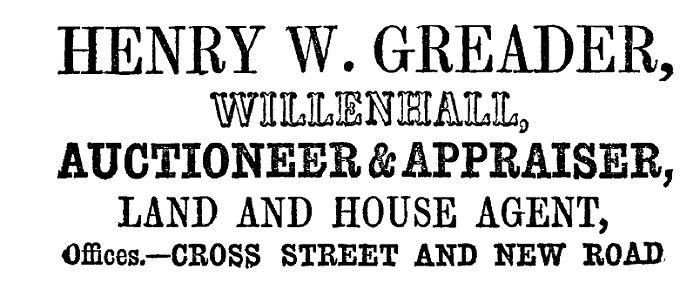
An advert from 1851.
In 1855 Willenhall Furnaces
began to operate on a site between the Bentley Canal, Sandbeds
Road, and Forge Road. The business was initially owned by Fletcher and Solly, who were later joined by Mr. Urwick, who provided extra
capital. They had three 45 ft. high blast furnaces, with a
maximum width of 13 ft. 6 inches. There were two calcining
kilns where crushed lime was burnt with the ore
before being transferred to the furnaces, and a
large coke hearth which converted coal to coke for
smelting. The blast for the three furnaces was provided by a 150 hp. condensing beam engine. The whole iron-making process soon became
more efficient when the waste gases were trapped at
the top of the furnaces and used to heat the blast
engine boilers, and later the blast itself.
The company owned several coal
mines in the area including the nearby Clothiers Colliery, which
supplied coal to the iron works via a 2 ft. 6 inch gauge
tramway, with about a mile of track. The wagons were hauled by horses until 1862, when they
were replaced by an 0-4-0 steam saddle tank locomotive, designed
and built by John Smith, at the Village Foundry in Coven. The
following year a second, more powerful 0-4-0 John Smith saddle
tank locomotive came into operation on the site. They hauled
around twenty five tons of coal each day from the nearby mines,
and coal from the nearby canal basin that came from Sneyd
Colliery, near Bloxwich, which was also owned by the firm. The
locomotives also hauled limestone and iron ore, which also
arrived by canal.
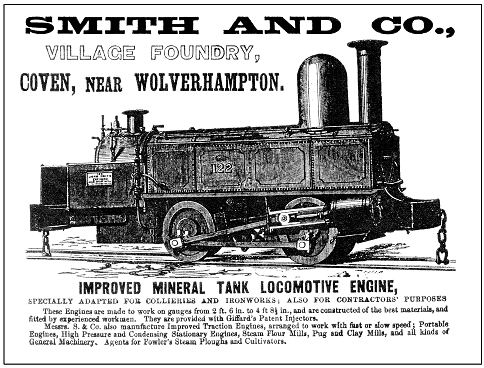
In 1872 when the Wolverhampton
and Walsall Railway opened, the company constructed a standard
gauge siding to Stafford Street Station and acquired a
second-hand standard gauge Sharpe Brothers 0-6-0 saddle tank.
The firm went public
in 1875 and became the Willenhall Furnaces Company Limited. At
the height of production around 500 tons of iron were produced each week. The
company became a victim of the depression in the iron trade, and
suffered from flooding problems in the mines. By 1881 only one
furnace was still in use. The business went into
receivership, and closed on the 9th April, 1881. |
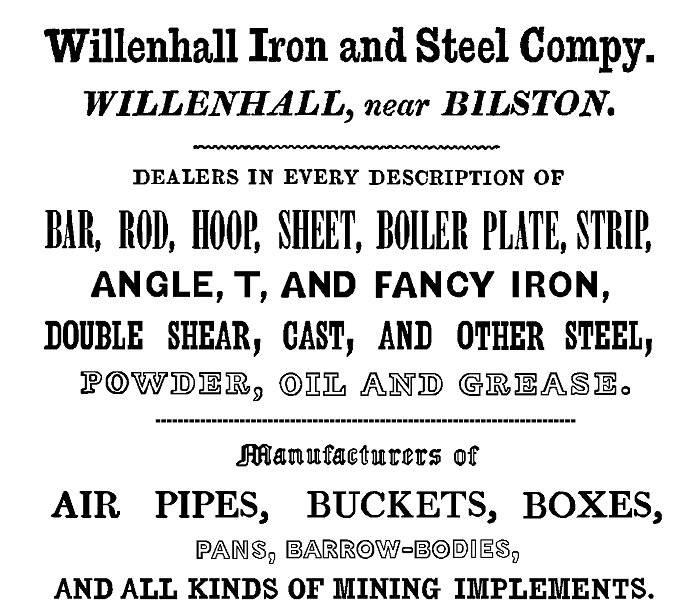
An advert from Slater's
Classified Directory of the Manufacturing
District, 15 Miles Around Birmingham. Published
in 1851. |
|
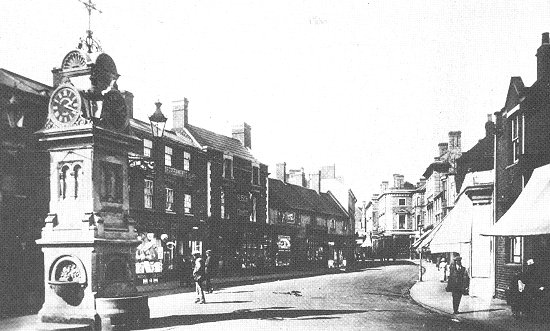
The Market Place around the
end of the First World War. |
Willenhall has had a thriving market for several
hundred years. In the 19th century the stalls were
erected below the old market cross, until a handsome
covered market was built.
Traders had to pay a rent to use the new
building, which soon closed because they preferred
to set up their stalls in the Market Place, which
was free. |
| The old market cross, as it was called,
consisted of a 2 storey building, with market stalls
on the ground floor, and a school room above. In the
18th century it was the site of the first open air
Methodist service in the town, and a site used for
bull baiting, until it was banned in 1825. Today’s elaborate market clock
was built in 1892 as a memorial to Joseph Tonks, a popular local
figure, who kept the Forge Inn in Spring Bank, and practised
medicine. The clock still has its original drinking fountain and
horse trough.
The town was well served by a
variety of shops. The directory lists 46 shops in the town
centre, although in actuality there were many more. The Market
Place was full of small shops, selling all kinds of goods and
services, so that locals could do most, if not all of their
shopping in the vicinity. In Lichfield Street was Willis
Butler’s hairdressers, and in Walsall Street stood Henry
Greader’s watch makers shop. Glass and china could be obtained
from John Harper in Wolverhampton Street, and books, stationery,
and printing were available at Charles Berry’s premises, also in
Wolverhampton Street. The chief constable, John Austin, could be
found at his bakers shop in Stafford Street, and in Church
Street there was even a steel truss maker in the form of Daniel
Read. |
| The post office
in Wolverhampton Street was run by postmaster John Tildesley. Letters from Walsall and parts east and south arrived by foot
post, every morning at eight, and were despatched every
afternoon at half past three.
Letters from Wolverhampton and
parts north and west, arrived by foot post every afternoon at
four, and were despatched every morning at half past seven. |
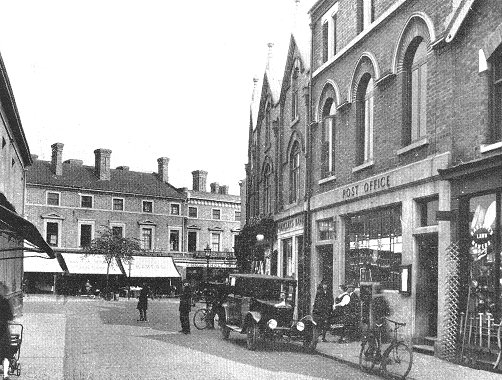
Wolverhampton Street in the
1920s. |
| Public Transport
People could easily travel to most parts of the
country by train, and local coaches and omnibuses
passed through the town.
Coaches called at the Neptune Inn, which was run by the Hartill
family and stood almost opposite St. Giles Church in Walsall
Street. The coach to Lichfield from Wolverhampton called at the
inn every morning except Sunday, at twenty minutes past nine. The
coach to Wolverhampton from Lichfield called at the Neptune
every afternoon except Sunday, at five p.m.
Omnibuses also called at the
Neptune. There were two omnibuses daily, except on Sundays, to
Birmingham, and two daily to Wolverhampton. There were also
omnibuses from the Three Crowns and the Queen's Arms.
Local carriers transported goods to Birmingham,
Wolverhampton, and Walsall. They included
Benjamin Smith, Wheatcroft and Company, John Shepherd, Ezekiel
Stokes, Pickford & Company, Mrs. Knowles, James Beddows, William
Fletcher, William Kendrick, and Joseph Lloyd.
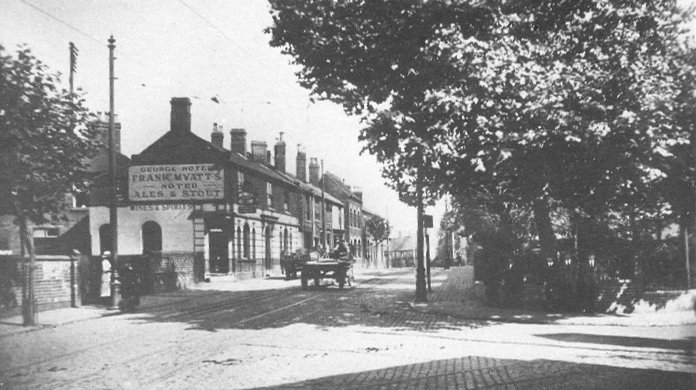
Looking into Walsall Street
from outside Dale House. From an old postcard.
Public Utility Services The town was supplied with gas
by the Willenhall Gas Company, which also supplied Essington,
Hilton, and parts of Bilston, and Darlaston. The company was
formed in 1837, and an Act of Parliament for incorporation was
Passed in 1857.
The company’s agent was John Greader, based in
Church Street. The gas works was originally in Lower
Lichfield Street, but couldn’t keep up with demand. |
|
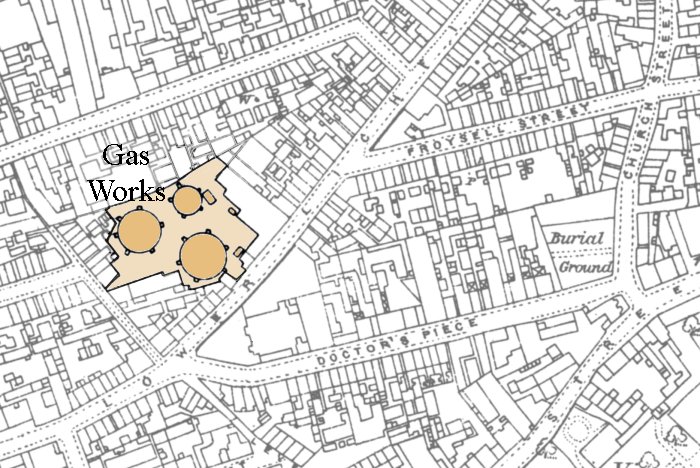
The location of the Gas
Works in Lower Lichfield Street. |
| Gas prices were initially as follows:
A single jet factory light - six pence per
week.
A double jet factory light - nine pence per
week.
A house or shop light - £2.2s.0d. per year.
A fish tail light - £2.10s.0d. per year.
A public house light - £3.3s.0d. per year. |
|

The new gas showroom and
offices. |
| In 1891 the company purchased a piece of land in
Clarkes Lane from the Hincks
family, on which to build a larger gas works. The company was one of the
first to charge for gas using British thermal units, after
obtaining an Order under the Gas Regulation Act of
1920. The company’s prices were some of the lowest
in the Midlands, with special discounts for
industrial customers. Labour saving devices were
installed at the works, which in the late 1930s carbonised around 27,000 tons
of coal a year. The company also produced around 11,000 tons of
coke annually. |
|
In 1935 a new office and
showroom was built in the Market Place, with a general stores,
fitting shops, and a cookery demonstration room. The building
opened in 1937 during the company’s centenary
celebrations.
The town was also supplied
with gas from the Mond Gas Company at Dudley Port, which
specialised in selling cheap gas to industrial users.
Electricity was supplied by the Midland Electric Corporation for
Power Distribution Limited, based at Toll End Road, Tipton. The
supply consisted of 200 volts, 2 phase, A.C. at 50Hz.
Water Supply
In 1859 water was obtained
from the Wolverhampton New Waterworks Company, founded in 1852.
In 1868 it was taken over by Wolverhampton Corporation.
Isolation Hospital
On 12th May, 1894 the Local
Board of Health decided to set up an isolation hospital to
isolate patients suffering from Small Pox which had reached
epidemic proportions in the town. Messrs. Wards
'Casting House' was acquired, and wooden buildings were added for
additional wards. Patients were transported to and from the
hospital in a horse-drawn ambulance, acquired for the purpose.
The hospital was built at a cost of £520, furnished for £300,
and had a maintenance bill of £500.
An early problem
was the cost of keeping patients at the hospital.
Initially they were each asked to pay 20 shillings a
week, which was a lot of money at the time. This was
soon withdrawn, and they were asked to pay whatever
they felt they could afford.
The hospital was
eventually taken over by the County Health
Authority, and survived until the 1920s when it
became surplus to requirements.
|
|
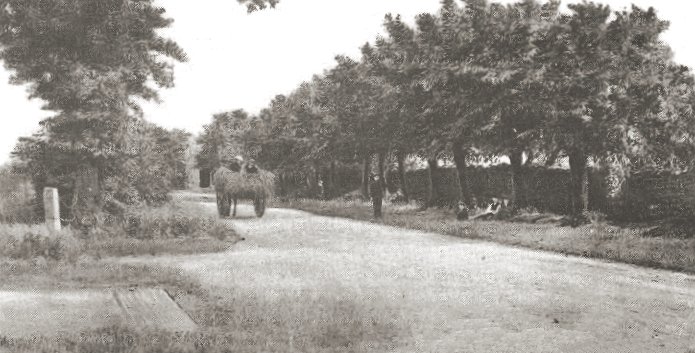
Neachells Lane in the early years
of the 20th century. The row of trees was known as
'Twenty Trees'. From an old postcard. |
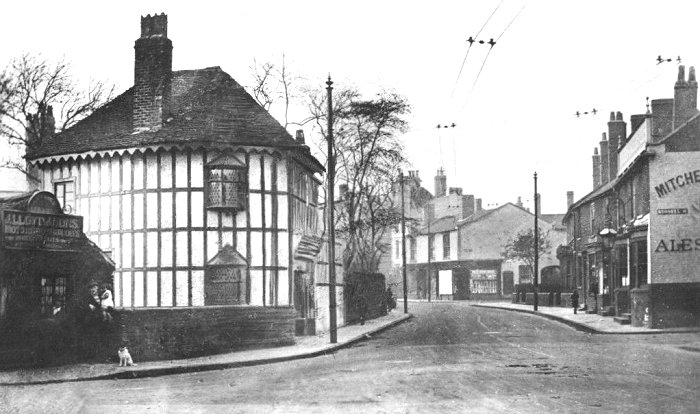
The Old Toll House. From an old postcard.
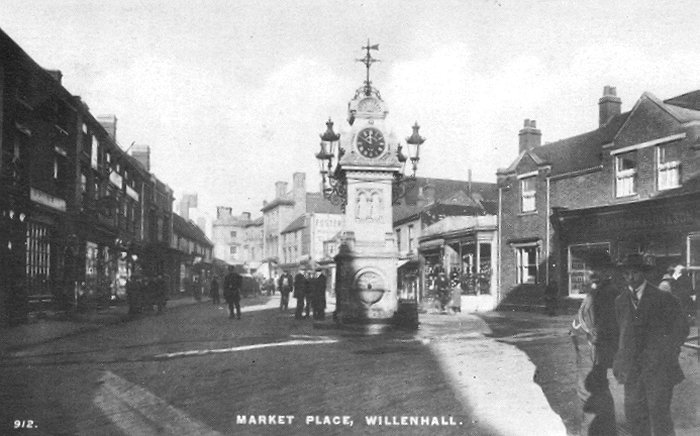
From an old postcard.
 |
|
 |
|
 |
Return to
Local Government |
|
Return to
the contents |
|
Proceed to Religion
and Churches |
|